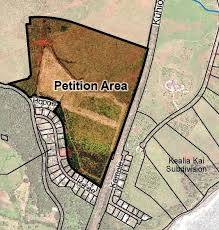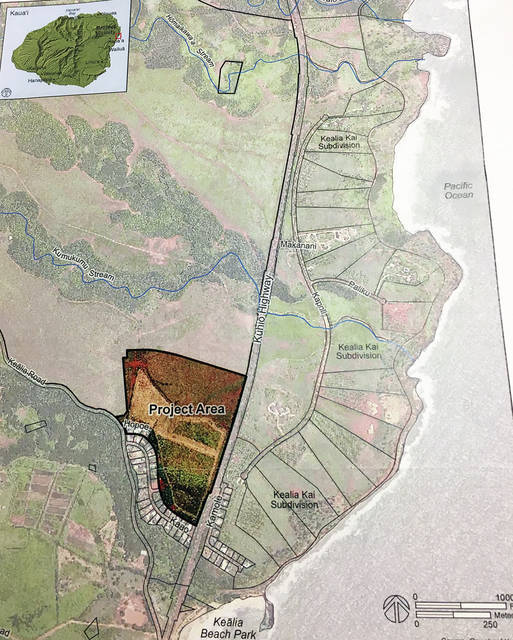Kealia Properties submits FEIS


KEALIA — Progress is ongoing for the Kealia Mauka Homesites, as a Final Environmental Impact Statement has been submitted to the state Land Use Commission.
The project set to serve about 200 residents is structured to sell empty lots, and has a real estate agent ready to make the sales — Mark Tanaka with Kauai Realty, according to representatives of the project’s developer Kealia Properties, LLC.
Now that the FEIS has been submitted, Kealia Properties is getting ready for a September Land Use Commission hearing to move through a boundary amendment process and switch 53 acres from agricultural district to the urban district.
Situated on former sugarcane land currently being used for cattle grazing, the project’s intent is to address the housing crisis.
“We understand that there is a very high number of kama‘aina families that will be able to enjoy homeownership in the price points that are being targeted, and that with sales restrictions the project can target that local market nicely,” according to a statement from Kealia Properties.
Kealia Properties is working to assure that first sales go to Kauai residents, with a preference for the workforce in Kapaa.
“We hope (that) will alleviate traffic through the Wailua-Kapaa corridor,” the statement said.
A decision has not been made on whether finished plans, permitted plans or completed homes will be offered.
It also includes infrastructure improvements — both on- and off-site, including utility improvements to support the subdivision along Kealia Road and within the Kuhio Highway right of way.
Studies related to the FEIS showed no presence of species listed as endangered or threatened under state or federal law. Predominately, bird species found in the area are red jungle fowl (chickens), cattle egret and the Western meadowlark.
Other animals found in the area include cattle and wild pigs and dogs.
“No endangered Hawaiian hoary bats were observed overflying the site. However, Hawaiian hoary bats are widely distributed in the low- to mid‐elevation areas on the island of Kauai, and have been documented in and around areas that still have dense vegetation,” the FEIS states.
Surveyors also acknowledged the flights of Hawaiian petrels and Newell’s shearwaters over the site annually, and light during construction will be shielded to help protect the birds.
Construction activity could impact water quality for nearby streams, however, and the FEIS states contractors will implement best-management practices to minimize soil erosion and sedimentation.
Community concerns in the draft EIS were that the project hasn’t been included in the Kauai General Plan.
Mike Dahilig, now county managing director and formerly county Planning Department director, addressed those concerns in a letter included in the FEIS explaining the project has been included in the General Plan since the 1980s.
•••
Jessica Else, environment reporter, can be reached at 245-0452 or jelse@thegardenisland.com.




Here’s what I wrote the Land Use Commission (at
dbedt.luc.web@hawaii.gov):
Commission should reject the Keälia Mauka Homesites amendment request.
I encourage the Commission to reject the request of Kealia Properties, LLC, to amend the boundaries of the State Land Use Agricultural District into the State Urban District.
The impact statement says “The purpose of the Proposed Action is to provide improved residential lots for sale to Kaua‘i residents.” What binds the proponent to ensuring that this “purpose” is fulfilled? Especially if “a block of lots could be sold to a single purchaser who would construct the finished homes for sale.” Would that purchaser have a similar purpose? How about a real estate flipper who buys a home from that single purchaser?
Earmarking only 36 of the 235 lots for affordable housing doesn’t fix this problem. (Regarding the other 199 lots – almost 85% of the project – the impact statement says “Prices of market lots will depend on market conditions at the time of sale.”)
The impact statement says “the intersection of Kūhiō Highway‐Keālia Road will experience a significant increase in traffic, with level of service being over capacity.” But not to worry, we’re told, “Other currently proposed roadway projects” will solve this problem. Notice that it says “proposed,” not “planned.” What happens before these proposals become a reality? What if they never become a reality? Let’s
Oh, and let’s not forget the “unresolved” issue with “either a wall or berm [that will] be installed along Kūhiō Highway” across from Kealia Beach. The purpose of the wall would be noise reduction – so we’re not talking about a four foot lava wall. It’s a bit disingenuous to say “The view looking mauka from Kūhiō will also be altered by the subdivision.” And, if it is a wall, how much highway noise will it divert back to one of the island’s most popular beaches?
While the county may have confirmed this area for development 35 years ago, a lot has changed since then. Did the county in 1984 envision a development that, in 2019, would (a) do little to solve an affordable housing crisis, (b) cause the major highway to reach “over capacity” use levels, and (c) involve a high fence or berm that would block the mouka view from Kealia Beach?
Until the Kapaa crawl is fixed we should have no new development on the Eastside unless they are in Lihue! Simple
Price points mentioned but no numbers to indicate what they say is affordable. Is $400,000 to $500,000 affordable for local families?
Did Kusaka get her land in the Kealia Kai area for the phony deal? There was a lot of public and land deal(s) corruption during those years also and all you have to do is read all about the Pflueger and Koloke Dam breach and Kealia Kai deal.
The disconnect from these public officials and their campaign donors are plain and simple about GREED. How much can they sell and pimp Kauai out to maximize their profits is a question that they salivate about every occasion that they have the opportunity to manipulate the plantation boys and gals.
The power hungry and money loving people on Kauai don’t care about anything else but the bottom line of increasing their bank accounts and their popularity amongst the so called powers.
The evil game of market manipulation and inflated prices are set by these mainland turds and the local sell outs. The triple taxes is another fleecing created by faux statements and state of emergencies.
Take a look at Rice street and the street going towards Wilcox school. These two projects cost was $10,000 a piece. Now how many county roads could they have fixed and improved traffic with that money instead of the luxury pork spending projects in areas that did not require any improvements. Maybe the roundabout was a good ideas but poorly planned and executed. They painted lanes for bikes that aren’t being used in a nature to suffice such spending.
The trick here is to understand the crisis that they create and have a solution already cooking the books. It’s a deceptive way to increase taxes by frustrating the masses. The county and state is good for the $4 for $1 ratio. It means that if they spend $1 then ask the Fed gov for $4 dollars then it’s a good investment but is it really a good investment when you have cronies and unfit people running the budget and not doing the work?
FEIS, was this statement a necessary part of acquiring the land? They are targeting a specific group for acquiring this property. More county funds to spend on acquiring the land does not sound good. Why pay extra for an FEIS just for a small group of people? This sounds like tax money spent for only the few who would be able to purchase land. Not good. This project looks like a lost cause. Buy a better project.